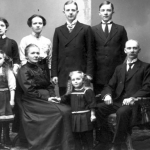Are you intrigued by your family history and yearn to explore your ancestral roots? Embarking on a genealogy research journey can be an exciting and rewarding experience, allowing you to uncover the stories and lives of your ancestors, deepen your understanding of your family’s past, and even discover distant relatives. However, the process of tracing your family tree can quickly become overwhelming without a solid plan in place. That’s why creating a genealogy research plan is essential to make the most of your time and efforts.
In this feature article, we’ll guide you through the process of creating a comprehensive research plan that will keep you organized, focused, and motivated throughout your genealogical journey. Whether you’re a seasoned family historian or just starting your adventure into the world of genealogy, this step-by-step guide will help you build a strong foundation for your research and ensure you’re well-equipped to uncover the fascinating stories and secrets hidden within your family’s past. So, let’s dive in and start creating a research plan that will help you unlock the mysteries of your family tree!
Setting Goals and Objectives
Before you embark on your genealogy journey, it’s crucial to establish clear and achievable goals. Setting goals not only helps you stay focused but also provides direction for your research. Begin by asking yourself what you hope to accomplish through your genealogical efforts. Are you trying to trace your family’s migration patterns over time? Or perhaps you want to verify (or debunk) a long-standing family legend? Whatever your objectives may be, identifying them at the outset will give your research a sense of purpose and prevent you from feeling overwhelmed by the sheer volume of information you’ll likely encounter.
It’s important to remember that genealogy research can be a complex and time-consuming process, so focusing on one objective at a time is a wise approach. Breaking down your larger goals into smaller, more manageable tasks will make your research more enjoyable and help you maintain momentum. You may even find that as you work toward one objective, new questions and areas of interest arise, leading you down new and exciting paths of discovery.
In summary, setting goals and objectives is an essential first step in creating a genealogy research plan. By establishing clear targets and focusing on one objective at a time, you’ll be well on your way to an organized and efficient family history investigation.
Gathering Preliminary Information
Once you’ve set your goals and objectives, the next step in creating a genealogy research plan is to gather any existing family records and information. This preliminary research phase will lay the groundwork for your investigation and provide valuable clues to guide your future research efforts.
Start by locating any family documents that may already be in your possession or that of your relatives. These can include family bibles, letters, photographs, diaries, and other personal items that have been passed down through generations. Don’t underestimate the power of these primary sources; they can reveal invaluable information about your ancestors and their lives.
Another essential resource in the preliminary information gathering stage is your living relatives. Interviewing older family members can offer unique insights and stories that may not be found in any written records. Take the time to speak with your parents, grandparents, aunts, uncles, and other relatives who may have memories or knowledge about your family history. Be sure to document these conversations, either by recording them or taking detailed notes, to ensure the information is preserved for future reference.
By collecting and examining these initial sources, you’ll be better prepared to delve deeper into your genealogy research. The preliminary information you gather will not only provide a solid foundation for your investigation but also help you identify the most relevant questions and resources to pursue in the next stages of your research plan.
Organizing Collected Data
As you start accumulating information and records about your ancestors, it’s essential to keep everything organized in a systematic manner. Proper organization will not only make it easier to find and reference specific details but also enable you to spot patterns and connections between different pieces of data.
There are several tools and software programs available that can help you organize your genealogical data effectively. Family tree software, for instance, allows you to visually map out your ancestors, track relationships, and store pertinent information about each individual. Alternatively, you may opt to use spreadsheets or online databases to keep your data organized and easily searchable.
In addition to digital organization methods, consider creating a physical filing system for any hard copies of documents, photographs, and other records you may have. A simple binder with labeled dividers or a filing cabinet with clearly marked folders can go a long way in keeping your physical records neat and accessible.
Regardless of the specific tools or methods you choose, the key to successful organization is consistency. Establish a system early on and stick to it, ensuring that you regularly update and maintain your records as you uncover new information. This will make it easier to track your progress, identify research gaps, and ultimately, make the most of your genealogy research efforts.
Identifying Research Gaps
After gathering preliminary information and organizing your data, you’ll likely begin to see patterns and connections between the various pieces of information you’ve collected. However, you may also notice that there are gaps or missing details in your family’s story. Identifying these research gaps is a crucial step in the genealogy research process, as it helps you determine the focus of your ongoing investigation.
To pinpoint the research gaps in your family history, take a moment to review your organized data and consider the questions that have arisen from your initial findings. Are there any ancestors whose birth or death dates are unknown? Or perhaps you’ve hit a brick wall in tracing your family’s migration from one location to another? Whatever the gaps may be, make a list of the most pressing questions you want to explore further.
It’s essential to approach these research gaps methodically, focusing on one question at a time. This will allow you to delve deeply into each issue, ensuring you thoroughly explore all available resources before moving on to the next question. Additionally, tackling one research gap at a time will help you maintain your focus and prevent you from becoming overwhelmed by the vast amount of information available.
In summary, identifying research gaps is a critical component of a well-structured genealogy research plan. By assessing your collected data and pinpointing the most pertinent questions, you can effectively target your research efforts and uncover the missing pieces of your family’s unique story.
Selecting Resources and Repositories
Now that you’ve identified your research gaps, it’s time to explore the wide array of resources and repositories available for genealogy research. With a vast number of options at your disposal, it’s essential to determine which resources are most relevant to your specific research questions. This will enable you to make the best use of your time and increase your chances of finding valuable information about your ancestors.
There’s no shortage of resources to help you delve deeper into your family history. Online databases, such as Ancestry.com, FamilySearch, and MyHeritage, offer access to millions of digitized records, including census data, birth and death certificates, military records, and more. In addition to online resources, don’t overlook the value of local archives, libraries, and historical societies, which can house unique collections of records and documents relevant to your family’s past.
As you identify the most pertinent resources for your research, make a list of the repositories you’d like to explore. This might include national archives, regional libraries, or even smaller, specialized collections housed at local historical societies. Be prepared to think outside the box; you never know where you might find a hidden gem of information about your ancestors.
When selecting resources and repositories, it’s important to be mindful of access restrictions and requirements. Some collections may require an appointment or a fee to access their materials, while others may have specific usage guidelines or limitations. Familiarize yourself with these requirements ahead of time to ensure a smooth research process.
By strategically selecting and accessing the most relevant resources and repositories, you’ll be well-equipped to fill in the gaps of your family’s history and bring your ancestors’ stories to life.
Creating a Research Log
As you delve deeper into your genealogy research, maintaining a research log becomes increasingly important. A research log is a detailed record of the resources you’ve consulted, the repositories you’ve visited, and the results of your investigations. Keeping a log not only helps you track your progress but also prevents you from duplicating efforts or overlooking valuable information.
An effective research log should include key details such as the date of your research session, the repository or resource you consulted, a brief description of the records you examined, the results of your investigation (whether positive or negative), and any pertinent notes or observations. Be sure to include enough detail to jog your memory when reviewing the log later, but keep it concise enough to be easily digestible.
There are numerous ways to maintain a research log, from simple pen-and-paper methods to digital tools like spreadsheets or specialized genealogy software. The best approach will depend on your personal preferences and the specific needs of your research project. Regardless of the format you choose, the key to a successful research log is consistency. Update your log regularly, and ensure that it’s organized and easily accessible.
In summary, creating and maintaining a research log is an invaluable aspect of a well-rounded genealogy research plan. By consistently documenting your research efforts, you’ll be better equipped to track your progress, stay organized, and make the most of your genealogy journey.
Evaluating and Analyzing Findings
As you progress through your genealogy research and uncover new information, it’s crucial to evaluate and analyze your findings critically. This means assessing the reliability of your sources, corroborating information between multiple records, and remaining open to the possibility that some details may need to be revised as new evidence comes to light.
One helpful concept to keep in mind during this process is the Genealogical Proof Standard (GPS), a set of guidelines used by professional genealogists to establish the credibility of their research. The GPS emphasizes the importance of conducting a thorough search of all available records, documenting and citing sources accurately, analyzing the evidence, and resolving any conflicting information. By following these guidelines, you can ensure that your genealogy research is as accurate and reliable as possible.
As you evaluate and analyze your findings, be prepared to revisit your research plan and make adjustments as needed. You may discover that new information leads you down an unexpected path or that certain research questions require further investigation. Embrace the fluid nature of genealogy research, and allow your findings to guide your ongoing efforts.
In conclusion, evaluating and analyzing your genealogy findings is a vital step in the research process. By critically assessing the evidence, adhering to the Genealogical Proof Standard, and remaining flexible in your research plan, you’ll be well on your way to uncovering the true stories of your ancestors and their lives.
Sharing and Preserving Research
After investing time and effort into your genealogy research, it’s natural to want to share your findings with others. Sharing your research not only allows you to connect with family members and fellow researchers but also helps to preserve your family’s history for future generations.
There are numerous ways to share and preserve your genealogy research, so consider the format that best suits your needs and preferences. You might choose to create a beautifully crafted family history book that can be passed down through generations or to build an online family tree that can be easily accessed and updated by relatives near and far. Alternatively, you could start a blog or use social media platforms to share your discoveries, stories, and photographs with a broader audience.
In addition to sharing your findings with others, it’s essential to preserve your research by storing documents, photographs, and other records safely. Invest in archival-quality storage materials to protect your physical records from damage and deterioration, and consider digitizing them for added security. Regularly back up your digital files and consider using cloud storage to ensure that your genealogy research is safeguarded against potential data loss.
In conclusion, sharing and preserving your genealogy research is a rewarding and vital aspect of the family history journey. By thoughtfully sharing your discoveries and taking steps to protect your records, you’ll help to ensure that your family’s unique stories and heritage are cherished and remembered for generations to come.
Conclusion
Embarking on a genealogy research journey can be an incredibly rewarding and enlightening experience, providing you with a deeper understanding of your family’s history and a connection to your ancestors. By creating a comprehensive genealogy research plan, you’ll be well-equipped to navigate the complexities of this endeavor and make the most of your time and efforts.
In this article, we’ve explored the essential steps to building a successful genealogy research plan, from setting clear goals and objectives to sharing and preserving your findings. With these guidelines in hand, you’re ready to begin your journey into the fascinating world of family history. Remember to stay organized, focused, and adaptable as you uncover the stories and secrets hidden within your family tree. Your ancestors are waiting to be discovered, and their tales are just waiting to be told. Happy researching!
Image Source:
- Photo by Glenn Carstens-Peters: Instant Images





